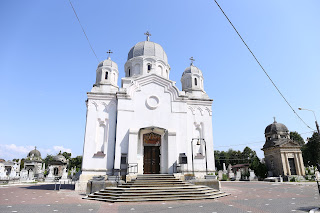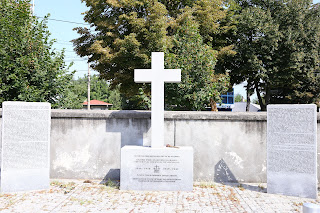
Historical and cultural context
The Armenian community in Botoșani, which has roots dating back to the medieval period, played a significant role in the city's economic, cultural, and social development. Adhering to Christianity as their state religion since 301, the Armenians established the first Armenian church in Botoșani—St. Mary’s Church in 1350—around which they built a school and the original Armenian cemetery. By the late 19th century, the cemetery was relocated from the Armenian quarter to its current site on Eternitatea Street, alongside an Orthodox cemetery. The Armenian cemetery remains a testament to the community’s rich heritage, preserving the memory of many notable figures from Botoșani's Armenian history.
Funerary architecture and art

The funerary monuments in the Armenian Cemetery are remarkable for their architectural and artistic style. The graves are often decorated with elaborate sculptures, inscriptions in Armenian, and specific religious symbols. These artistic elements offer insight into the traditions and values of the Armenian community, making it a point of interest for historians, anthropologists, and art enthusiasts. Each monument tells a story, providing clues about the life and legacy of those buried there.
Some of the most notable monuments are:
- Funeral Monument of Cristea David (1802-1883) and Flora Goilav (1818-1907),
- Funeral Monument of Christea Manea Loizanu,
- Jon J. Ciomac funeral monument,
- Dr. Andrei Manea funeral monument,
- Gheorghe Christea Goilav funeral monument.
Education and public awareness

The Armenian Cemetery stands as an open-air museum and plays a crucial role in educating the public about the cultural and historical diversity of Botoșani. By organizing guided tours, workshops, and cultural events, the cemetery becomes a place of learning and reflection. These activities help raise awareness and appreciation of Armenian cultural heritage among both locals and visitors.
Community interaction

The peaceful and solemn atmosphere of the cemetery offers a conducive space for meditation and remembrance, being a place where people can reflect on life, history, and traditions. But it is not just a place of memory but also a meeting point for the community. Commemorative events and religious ceremonies bring together members of the Armenian community and those interested in its history and culture. These interactions strengthen social ties and preserve cultural traditions.
International perspectives
International collaborations, such as the visit by representatives of the Ministry of Culture in Poland and students of Armenian descent, highlight the importance of the Armenian Cemetery in Botoșani in a global context. These collaborations not only promote the exchange of knowledge and best practices but also strengthen cultural and historical ties between different nations.
Cemetery address
10 Eternității Street710321 Botoșani
Romania
Contacts
CNIPT Botosani(Botoșani National Center for Tourist Information and Promotion)
Phone: +40 231 519 519
Website: visit@visitbotosani.ro
Basic data
Year of first burial: 1881Cemetery area: 2ha
Approximate number of graves: 378
Approximate number of yearly burials: 5


















